A Wingless and Notch double-repression mechanism regulates G1-S transition in the Drosophila wing
- PMID: 18451803
- PMCID: PMC2426722
- DOI: 10.1038/emboj.2008.84
A Wingless and Notch double-repression mechanism regulates G1-S transition in the Drosophila wing
Abstract
The control of tissue growth and patterning is orchestrated in various multicellular tissues by the coordinated activity of the signalling molecules Wnt/Wingless (Wg) and Notch, and mutations in these pathways can cause cancer. The role of these molecules in the control of cell proliferation and the crosstalk between their corresponding pathways remain poorly understood. Crosstalk between Notch and Wg has been proposed to organize pattern and growth in the Drosophila wing primordium. Here we report that Wg and Notch act in a surprisingly linear pathway to control G1-S progression. We present evidence that these molecules exert their function by regulating the expression of the dmyc proto-oncogene and the bantam micro-RNA, which positively modulated the activity of the E2F transcription factor. Our results demonstrate that Notch acts in this cellular context as a repressor of cell-cycle progression and Wg has a permissive role in alleviating Notch-mediated repression of G1-S progression in wing cells.
Figures
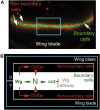

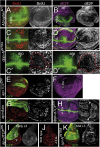
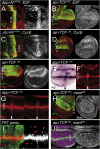

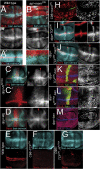

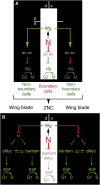
Similar articles
-
Lines is required for normal operation of Wingless, Hedgehog and Notch pathways during wing development.Development. 2009 Apr;136(7):1211-21. doi: 10.1242/dev.021428. Development. 2009. PMID: 19270177 Free PMC article.
-
Repression of dMyc expression by Wingless promotes Rbf-induced G1 arrest in the presumptive Drosophila wing margin.Proc Natl Acad Sci U S A. 2004 Mar 16;101(11):3857-62. doi: 10.1073/pnas.0400526101. Epub 2004 Mar 4. Proc Natl Acad Sci U S A. 2004. PMID: 15001704 Free PMC article.
-
Myoblast cytonemes mediate Wg signaling from the wing imaginal disc and Delta-Notch signaling to the air sac primordium.Elife. 2015 May 7;4:e06114. doi: 10.7554/eLife.06114. Elife. 2015. PMID: 25951303 Free PMC article.
-
The Impact of Drosophila Awd/NME1/2 Levels on Notch and Wg Signaling Pathways.Int J Mol Sci. 2020 Oct 1;21(19):7257. doi: 10.3390/ijms21197257. Int J Mol Sci. 2020. PMID: 33019537 Free PMC article.
-
A positive role of Sin3A in regulating Notch signaling during Drosophila wing development.Cell Signal. 2019 Jan;53:184-189. doi: 10.1016/j.cellsig.2018.10.008. Epub 2018 Oct 12. Cell Signal. 2019. PMID: 30316814
Cited by
-
Identification of cis-Regulatory Elements in the dmyc Gene of Drosophila Melanogaster.Gene Regul Syst Bio. 2012;6:15-42. doi: 10.4137/GRSB.S8044. Epub 2011 Dec 21. Gene Regul Syst Bio. 2012. PMID: 22267917 Free PMC article.
-
Src kinase function controls progenitor cell pools during regeneration and tumor onset in the Drosophila intestine.Oncogene. 2015 Apr 30;34(18):2371-84. doi: 10.1038/onc.2014.163. Epub 2014 Jun 30. Oncogene. 2015. PMID: 24975577
-
bantam miRNA is important for Drosophila blood cell homeostasis and a regulator of proliferation in the hematopoietic progenitor niche.Biochem Biophys Res Commun. 2014 Oct 24;453(3):467-72. doi: 10.1016/j.bbrc.2014.09.109. Epub 2014 Oct 1. Biochem Biophys Res Commun. 2014. PMID: 25280996 Free PMC article.
-
Myc-regulated miRNAs modulate p53 expression and impact animal survival under nutrient deprivation.PLoS Genet. 2023 Aug 28;19(8):e1010721. doi: 10.1371/journal.pgen.1010721. eCollection 2023 Aug. PLoS Genet. 2023. PMID: 37639481 Free PMC article.
-
The fate of notch-1 transcript is linked to cell cycle dynamics by activity of a natural antisense transcript.Nucleic Acids Res. 2021 Oct 11;49(18):10419-10430. doi: 10.1093/nar/gkab800. Nucleic Acids Res. 2021. PMID: 34520549 Free PMC article.
References
-
- Axelrod JD, Matsuno K, Artavanis-Tsakonas S, Perrimon N (1996) Interaction between wingless and Notch signaling pathways mediated by Dishevelled. Science 271: 1826–1832 - PubMed
-
- Baena-Lopez LA, Garcia-Bellido A (2003) Genetic requirements of vestigial in the regulation of Drosophila wing development. Development 130: 197–208 - PubMed
-
- Baonza A, Freeman M (2005) Control of cell proliferation in the Drosophila eye by Notch signaling. Dev Cell 8: 529–539 - PubMed
-
- Bienz M, Clevers H (2000) Linking colorectal cancer to Wnt signaling. Cell 103: 311–320 - PubMed
Publication types
MeSH terms
Substances
LinkOut - more resources
Full Text Sources
Molecular Biology Databases

